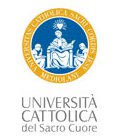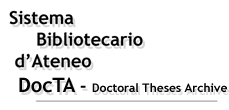|
|
DocTA - Doctoral Theses Archive >
Tesi di dottorato >
CORSO DI DOTTORATO IN LINGUISTICA APPLICATA E LINGUAGGI DELLA COMUNICAZIONE >
Citazione:
Utilizza queste indicazioni per citare o creare un link a questo documento.
|
Bergonzi, Silvia. "STILI COMUNICATIVI E STILI DI APPRENDIMENTO NELL'INSEGNAMENTO DELL'ITALIANO LS A DISCENTI GIAPPONESI E SVEDESI", Università Cattolica del Sacro Cuore, XX ciclo, a.a. 2007/08, Milano, [http://hdl.handle.net/10280/508].
|
| Titolo: | STILI COMUNICATIVI E STILI DI APPRENDIMENTO NELL'INSEGNAMENTO DELL'ITALIANO LS A DISCENTI GIAPPONESI E SVEDESI |
| Autore/i: | BERGONZI, SILVIA |
| Tutor: | ZANOLA, MARIATERESA
GOBBER, GIOVANNI |
| Coordinatore: | GOBBER, GIOVANNI |
| Lingua: | ITA |
| Abstract in italiano della tesi: | La presente ricerca intende indagare alcune tendenze interazionali di discenti giapponesi e svedesi in relazione alla cultura dei parlanti e al processo comunicativo che ha luogo nell’insegnamento dell’italiano all’estero. Gli stili comunicativi e gli stili di apprendimento costituiscono lo sfondo della dinamica di rapporto fra docente e studente. Tali elementi si manifestano in interazioni interculturali attraverso una co-occorrenza di regolarità caratteristiche della comunità linguistica a cui i discenti appartengono. Osservando lo stile comunicativo degli studenti si nota che alcune strategie interazionali riflettono valori culturali a cui è legato il senso della politeness, così come percepito dalla loro comunità linguistica. Il trasferimento di strategie comunicative da una lingua all’altra può dare origine a dissonanze nelle interazioni tra docenti e studenti, inficiando il processo comunicativo che permette di attuare pragmaticamente l’azione didattica, compromettendone talvolta il buon esito. Le modalità interazionali degli studenti riflettono lo stile comunicativo della comunità linguistica di cui fanno parte, mentre la tradizione della didattica delle lingue straniere permette di comprendere gli stili di apprendimento dei discenti. Si comprende così la centralità che hanno la cultura dei parlanti e il processo comunicativo, ai fini dell’insegnamento e dell’apprendimento delle lingue all’estero. |
| Abstract in inglese: | The aim of the present research is to investigate some interactional features of Japanese and Swedish students as regards the culture of the speakers and the process of communication involved in the teaching of Italian as a foreign language. Communication styles and learning styles form the background of the dynamics in the relationship between the lecturer and the student. Such elements can be perceived in intercultural communications, especially by a co-occurrence of regularities that are distinctive of the language community the students belong to. By observing the communication styles of the students one can see that some interactional strategies reflect cultural values that are strictly connected to the sense of politeness, as perceived by a language community. Transferring communicative strategies from one language to another can produce dissonances in the interactions between the lecturer and the students; this in turn can affect the process of communication in its pragmatic application of the teaching, at times making it less successful. The communication styles of the students reflect those of the language community they belong to, whereas the foreign language teaching tradition allows one to comprehend their styles of learning. Thus one can rediscover the central role of culture and communication in the process of teaching a foreign language abroad. |
| Data di discussione: | 1-apr-2009 |
| URI: | http://hdl.handle.net/10280/508 |
| È visualizzato nelle collezioni: | CORSO DI DOTTORATO IN LINGUISTICA APPLICATA E LINGUAGGI DELLA COMUNICAZIONE
FACOLTA' DI SCIENZE LINGUISTICHE E LETTERATURE STRANIERE
|
File in questo documento:
| File |
Descrizione |
Dimensioni | Formato | Accessibilità |
|---|
| 01frontespizio.pdf | frontespizio | 248 kB | Adobe PDF | non consultabile
|
| abstract italiano.pdf | abstract italiano | 100,52 kB | Adobe PDF | non consultabile
|
| abstract inglese.pdf | abstract inglese | 98,67 kB | Adobe PDF | non consultabile
|
| ringraziamenti.pdf | ringraziamenti | 58,35 kB | Adobe PDF | non consultabile
|
| indice.pdf | indice | 134,8 kB | Adobe PDF | non consultabile
|
| introduzione.pdf | introduzione | 133,41 kB | Adobe PDF | non consultabile
|
| I capitolo.pdf | I capitolo | 432,63 kB | Adobe PDF | non consultabile
|
| II capitolo.pdf | II capitolo | 632,18 kB | Adobe PDF | non consultabile
|
| III capitolo.pdf | III capitolo | 902,56 kB | Adobe PDF | non consultabile
|
| IV capitolo.pdf | IV capitolo | 423,68 kB | Adobe PDF | non consultabile
|
| V capitolo.pdf | V capitolo | 475,03 kB | Adobe PDF | non consultabile
|
| conclusione.pdf | conclusione | 89,86 kB | Adobe PDF | non consultabile
|
| bibliografia.pdf | bibliografia | 288,01 kB | Adobe PDF | non consultabile
|
| testo_completo.pdf | testo_completo | 2,36 MB | Adobe PDF | non consultabile
|
|
Accesso e utilizzo dei contenuti di DocTA
|



